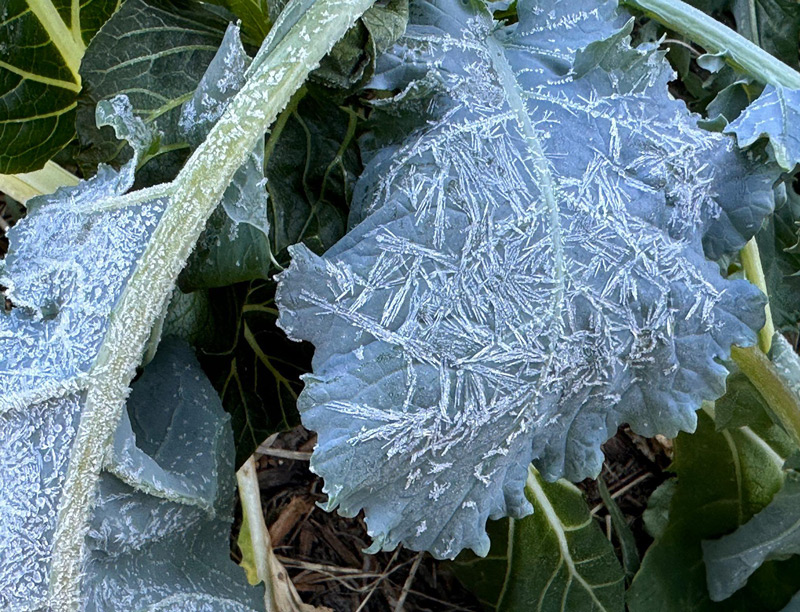This week I posted a video sharing some thoughts on how to maintain a winter food supply:
Basically, we keep a regular supply of food through the chillier months via:
- Keeping animals that produce meat, milk and some eggs
- Continuing to grow the vegetables that can take the frosts
- Storing up the bounty of summer and fall
Animal Foods Through Winter
Our cows are a great blessing, as we get three gallons of milk per day right through the winter. When you have milk, you can also have cheese, yogurt, butter, kefir and other dairy products that are nutritious and filling.
We can take five gallons of milk and skim off the cream to make butter, then make a good-sized cheese from the remaining milk.
Then we can take the remaining whey and soak grains in it for our chickens, raising the protein and nutrition they get, and/or we can feed it to our piglets to fatten them up. We can also drink it ourselves!
We don’t add lights to the chicken coop, so we only get a few eggs a day through winter – yet those few eggs do help keep us fed.
In the fall, we butchered two pigs and the freezer is full of pork right now, which means we are quite set for meals. I’ve made one slab of bacon so far and plan on starting to cure two more today, as the first bacon was delicious and turned out quite well. We’ve also made incredibly good breakfast sausage with our ground pork and will be making more as we work our way through the 400+ lbs of meat in the freezer.
When the plant foods are mostly gone due to the cold, animal foods are often still available.
Growing Vegetables that Take the Cold
We have multiple vegetables still hanging on in the garden right now, including rutabagas, green onions, mustards, pak choi and daikon radishes. These can take temperatures down into the low twenties.
We’re supposed to hit the mid-teens next week, however, which means we’ll have to cover our vegetable beds with sheets for a few nights. They should survive, but if they don’t, we still have lots of stored vegetables from summer and fall.
Storing Garden Produce Through Winter
We haven’t don’t much canning over the last couple of years, but we do keep a lot of roots and pumpkins through winter. Our favored pumpkin varieties are long-keepers, like the Seminole pumpkin, and they sit around our house as decorations until we eat them all. This usually doesn’t happen until some time next summer. We still have hundreds of pounds of pumpkins right now!
We also store sweet potatoes and true yams in cardboard boxes, often layered in dry hay, and pull them as we need them. Between these stored roots, the pork in the fridge, and a few fresh cold-hardy vegetables and herbs in the garden, we eat well right through the winter.
We are fortunate to live in a climate with relatively mild winters, as we only need to prepare for about 4-5 months of occasional garden-killing frosts; yet this would normally be a hungry season, since even one night in the teens effectively ends all the bounty of summer. Over the years, we’ve gotten better at growing easy-to-store crops in summer and fall with some cold-hardy plants over the winter in beds outdoors – and we’ve gotten much better at managing animals on the homestead and providing our own meat and cooking fat (lard).
It’s possible to stay fed in the winter, particularly if you imitate the ant, not the grasshopper.


5 comments
Plant foods that can be stored without refrigeration over a temperate winter:
In-shell nuts
Dried seeds – grains, beans, sunflower, sesame, etc .
Dried fruit
Dried herbs
Some winter squash (as mentioned in your article).
Also the traditional “root cellar” approach can be used to preserve many root crops over winter.
Greens can be supplied by sprouting seeds, grains, if leafy veggies are not in-season/not available.
Yes, very good list.
Glad to hear that you spend nearly a year eating one season’s pumpkins – gives me hope about my butternut squash and sweet potatoes. Pumpkins this year!
Yes! They last a long time.
I have an inquiry. When I visited the Yucatan many years ago, I saw first hand how the locals gardened. They would grow squashes and beans in former forested areas – in and among the many rocks, tree stumps, and various structures. The results seemed good and healthy. I’m wondering about doing the same thing here on my property in NC (which is 80% wooded) – clearing a patch of trees, leaving the stumps and bigger rocks and just building the soils around them, planting mostly pumpkins and squash. Stump and big rock removal is back-breaking. Have you seen this technique, or have you tried it? Any recommendations?
Comments are closed.